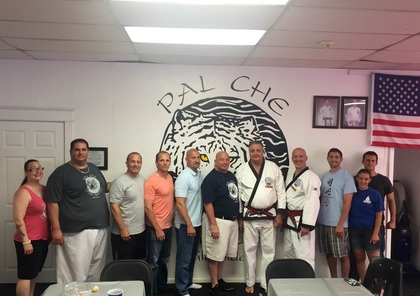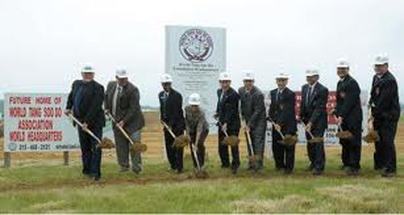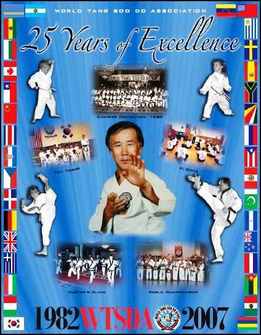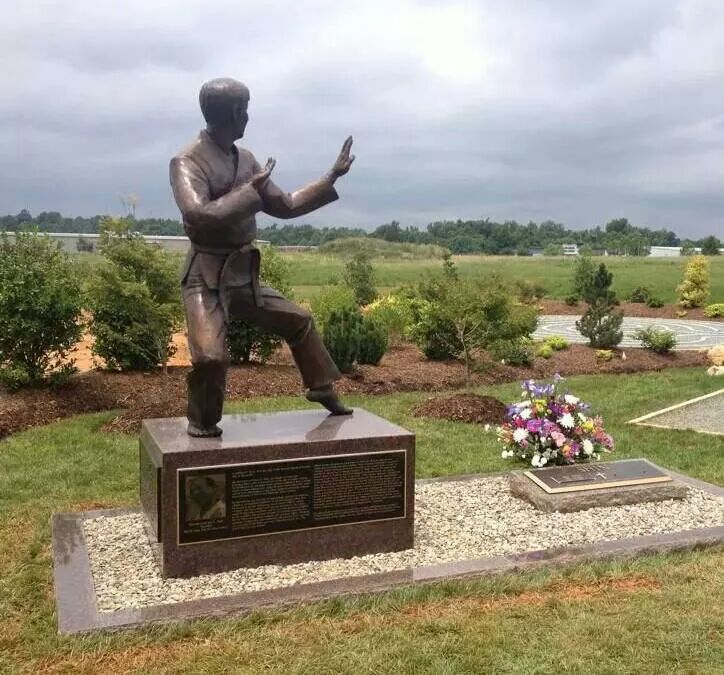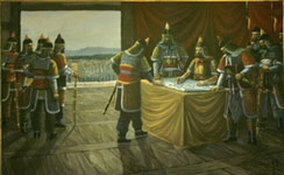History
History of Pal Che Tang Soo Do
In April 1990 Mr. Dennis DiMarco, #19980 and Mr. Ronald Raver, #20711, both Third Degree Black Belts (Sam Dan) who had begun their training under Masters Young H. Kwon and Young K. Kwon, opened the Tang Soo Do Institute at a small storefront in Glenolden, Pennsylvania. The first official class was held on April 16, 1990 with ten students in attendance. The Logo was a drawing of Two Dragons (one representing each instructor) holding the Um-Yang Symbol in the center. It was adopted from the Black Belt Club Name and Logo from Tang Soo Do Karate Academy where they were then training under Master Mark Causerano on Haverford Avenue in Philadelphia.
On May 5th, 1990, there was an Official Grand Opening where the flags and portraits were hung. There were 19 students at this time. Mr. DiMarco and Mr. Raver put on a small demonstration, and the East Coast Demo Team also performed. Classes were five days each week. In 1990 at the World Championships held at the Philadelphia Civic Center, the school performed very well bringing home many trophies, sometimes sweeping the divisions. Things moved along smoothly and in 1992 Mr. DiMarco was invited to the Masters' Clinic and was successful in his promotion to Fourth Degree Black Belt Master (Sah Dan) in October 1992. In May 1993, Tang Soo Do Institute had their first Black Belts. Among them was Mr. Joseph Centrone, #25080. Mr. Raver tested for the rank of Fourth Degree Black Belt Master (Sah Dan) in 1994 and was successful, receiving his ranking at the World Championships in Orlando, Florida that Summer.
In the Spring of 1996 Master DiMarco and Master Raver had grown apart and decided to dissolve their partnership in the Tang Soo Do Institute. Master Raver retained the studio location in Glenolden and incorporated the new Studio (Dojang) as Pal Che Tang Soo Do meaning "Selection of the Best", using a "White Tiger in Water" drawing by Karen Philips from Florida as the logo for the new school. Master DiMarco moved and opened a school with the same name, Tang Soo Do Institute, on MacDade Boulevard, but it only remained open for several months until he moved to a location in Pennsburg, Pennsylvania.
The Studio (Dojang) continued to grow, and in 1999 Master Raver retired from Sunoco to operate the school full time. It was at this time when we began Kids Karate Programs for young children called Tiny Tigers. In October 2002, after having been promoted to Fifth Degree Black Belt (Oh Dan), Mr. Raver retired as Owner of Pal Che Tang Soo Do and Cheif Instructor, Mr. Joseph Centrone, who was the first Black Belt ever from this school assumed ownership of the studio. A ceremony was held to signify the transfer of the school from one teacher to the next, and new flags were hung. Under his leadership, the school reached its largest student population of 100 students in early 2004. The school facility expanded from just one training room, an office, and a small lobby to its much larger current size with an expanded training floor and a larger lobby with many renovations taking place for both students and parents alike.
In 2005, Mr. Vincent Melchiorre, #25050, an attorney and personal friend of Mr. Centrone, transferred to Pal Che Tang Soo Do from Shin Karate in South Philadelphia, and he became a weekly Instructor. In October 2005 Mr. Centrone and Mr. Melchiorre, were promoted to Fourth Degree Black Belts (Sah Dan), each receiving their Master Rank the following year. In 2008, Master Melchiorre opened a Club (Dojang), Dragon's Den Martial Art, in his community of Voorhees, New Jersey. He then returned to the re-named Castelli’s Shin Karate in Philadelphia, where he began his Tang Soo Do training many years before and later transferred to Nate Gordon's Black Belt Academy in Bensalem, PA. In 2008, students Master George Celona, #30090, and Ms. Angel Evangelista-Celona, #31088, branched off to open their own Studio, Impact Martial Arts, in Cecil County, Maryland. In May 2010, Pal Che Tang Soo Do celebrated its 20th Anniversary.
After years of growth and expansion, Master Centrone retired in May 2011, turning Pal Che Tang Soo Do over to longtime student of 15 years, Studio Manager, and Head Instructor Mr. Nicholas D 'Amato, #36548, who had recently earned his Third Degree Black Belt (Sam Dan). In 2011, the inside of the Studio was again renovated and new signs were made for outside facade of the building. On October 8th, 2011, there was a Grand Re-Opening, and many new students joined the school. Within the first year of Mr. D'Amato's leadership, the school has more than doubled in size and new training curriculum and promotion guidelines have been adopted. Standardized programs and pricing have been instituted, and the class schedule has also been expanded to accommodate the growth of the Tiny Tigers and Little Dragons Programs.
In 2012, Pal Che Tang Soo Do and Impact Martial Arts instituted a Joint Leadership Program between the 2 Studios (Dojang). In 2015, student Mr. Anthony DiLucido, #37553, opened a Club, Ignite Martial Arts, which operated until 2017, in Bloomsburg, Pennsylvania. In June 2015, Pal Che Tang Soo Do celebrated its 25th Anniversary. In June 2020, Pal Che Tang Soo Do celebrated its 30th Anniversary! In 2022, Pal Che Tang Soo Do expanded to a second location in Brookhaven after acquiring the former MBMA Karate, Inc. Studio which had operated there for over 20 years. The Members of that Studio then joined the World Tang Soo Do Association.
In all, over 1,000 students have trained at this small school with little parking in Glenolden. There have been over 80 Black Belts, 6 Masters, and several others who are on their way to Master's Rank.
On May 5th, 1990, there was an Official Grand Opening where the flags and portraits were hung. There were 19 students at this time. Mr. DiMarco and Mr. Raver put on a small demonstration, and the East Coast Demo Team also performed. Classes were five days each week. In 1990 at the World Championships held at the Philadelphia Civic Center, the school performed very well bringing home many trophies, sometimes sweeping the divisions. Things moved along smoothly and in 1992 Mr. DiMarco was invited to the Masters' Clinic and was successful in his promotion to Fourth Degree Black Belt Master (Sah Dan) in October 1992. In May 1993, Tang Soo Do Institute had their first Black Belts. Among them was Mr. Joseph Centrone, #25080. Mr. Raver tested for the rank of Fourth Degree Black Belt Master (Sah Dan) in 1994 and was successful, receiving his ranking at the World Championships in Orlando, Florida that Summer.
In the Spring of 1996 Master DiMarco and Master Raver had grown apart and decided to dissolve their partnership in the Tang Soo Do Institute. Master Raver retained the studio location in Glenolden and incorporated the new Studio (Dojang) as Pal Che Tang Soo Do meaning "Selection of the Best", using a "White Tiger in Water" drawing by Karen Philips from Florida as the logo for the new school. Master DiMarco moved and opened a school with the same name, Tang Soo Do Institute, on MacDade Boulevard, but it only remained open for several months until he moved to a location in Pennsburg, Pennsylvania.
The Studio (Dojang) continued to grow, and in 1999 Master Raver retired from Sunoco to operate the school full time. It was at this time when we began Kids Karate Programs for young children called Tiny Tigers. In October 2002, after having been promoted to Fifth Degree Black Belt (Oh Dan), Mr. Raver retired as Owner of Pal Che Tang Soo Do and Cheif Instructor, Mr. Joseph Centrone, who was the first Black Belt ever from this school assumed ownership of the studio. A ceremony was held to signify the transfer of the school from one teacher to the next, and new flags were hung. Under his leadership, the school reached its largest student population of 100 students in early 2004. The school facility expanded from just one training room, an office, and a small lobby to its much larger current size with an expanded training floor and a larger lobby with many renovations taking place for both students and parents alike.
In 2005, Mr. Vincent Melchiorre, #25050, an attorney and personal friend of Mr. Centrone, transferred to Pal Che Tang Soo Do from Shin Karate in South Philadelphia, and he became a weekly Instructor. In October 2005 Mr. Centrone and Mr. Melchiorre, were promoted to Fourth Degree Black Belts (Sah Dan), each receiving their Master Rank the following year. In 2008, Master Melchiorre opened a Club (Dojang), Dragon's Den Martial Art, in his community of Voorhees, New Jersey. He then returned to the re-named Castelli’s Shin Karate in Philadelphia, where he began his Tang Soo Do training many years before and later transferred to Nate Gordon's Black Belt Academy in Bensalem, PA. In 2008, students Master George Celona, #30090, and Ms. Angel Evangelista-Celona, #31088, branched off to open their own Studio, Impact Martial Arts, in Cecil County, Maryland. In May 2010, Pal Che Tang Soo Do celebrated its 20th Anniversary.
After years of growth and expansion, Master Centrone retired in May 2011, turning Pal Che Tang Soo Do over to longtime student of 15 years, Studio Manager, and Head Instructor Mr. Nicholas D 'Amato, #36548, who had recently earned his Third Degree Black Belt (Sam Dan). In 2011, the inside of the Studio was again renovated and new signs were made for outside facade of the building. On October 8th, 2011, there was a Grand Re-Opening, and many new students joined the school. Within the first year of Mr. D'Amato's leadership, the school has more than doubled in size and new training curriculum and promotion guidelines have been adopted. Standardized programs and pricing have been instituted, and the class schedule has also been expanded to accommodate the growth of the Tiny Tigers and Little Dragons Programs.
In 2012, Pal Che Tang Soo Do and Impact Martial Arts instituted a Joint Leadership Program between the 2 Studios (Dojang). In 2015, student Mr. Anthony DiLucido, #37553, opened a Club, Ignite Martial Arts, which operated until 2017, in Bloomsburg, Pennsylvania. In June 2015, Pal Che Tang Soo Do celebrated its 25th Anniversary. In June 2020, Pal Che Tang Soo Do celebrated its 30th Anniversary! In 2022, Pal Che Tang Soo Do expanded to a second location in Brookhaven after acquiring the former MBMA Karate, Inc. Studio which had operated there for over 20 years. The Members of that Studio then joined the World Tang Soo Do Association.
In all, over 1,000 students have trained at this small school with little parking in Glenolden. There have been over 80 Black Belts, 6 Masters, and several others who are on their way to Master's Rank.
History of the World Tang Soo Do Association
In 1968 Master Jae Chul Shin came to the United States of America as a Representative of the Korean Soo Bahk Do Association. He formed the United States Tang Soo Do Federation in Burlington, New Jersey that same year. After over a decade of expansion, Master Shin decided to restructure the organization to meet new international demands. A Charter Convention was held on November 13th-14th, 1982 in Philadelphia, Pennsylvania, which founded of the World Tang Soo Do Association. At the convention a new constitution was passed, a new logo and insignia were selected, the uniform and belt system were revised, and new organizational standards were adopted. Also at this convention, Master Jae Chul Shin was recognized as the Grandmaster of the World Tang Soo Do Association.
The World Tang Soo Do Association is divided into 23 different Regions, each with its own Director and Events. The World HeadQuarters was located on Oregon Avenue in South Philadelphia, Pennsylvania, which is in Region 8. The Association has taken nine official expedition trips to Korea and China so that students can learn about the roots of Tang Soo Do and train where the Art was founded. The World Championships have been held every two years since 1986. In 1990, GrandMaster Jae Chul Shin envisioned a new home for the organization where there would be a permanent place where all World Tang Soo Do Practitioners could visit and train, and the Building Fund was created for a new HeadQuarters. After many years of dedicated searching, in 2012, the World HeadQuarters has relocated to Burlington, North Carolina.
The World Tang Soo Do Association stands for three mottos, Traditionalism, Professionalism and Brotherhood/Sisterhood. These mottos evoked the interest of many martial artists, whose genuine interest was in studying the Art and was not sport orientated. The World Tang Soo Do Association has become one of the most respected traditional martial art organizations worldwide, with over 700 schools present in more than 30 countries as well as over 100,000 members and 15,000 Black Belts.
The World Tang Soo Do Association is divided into 23 different Regions, each with its own Director and Events. The World HeadQuarters was located on Oregon Avenue in South Philadelphia, Pennsylvania, which is in Region 8. The Association has taken nine official expedition trips to Korea and China so that students can learn about the roots of Tang Soo Do and train where the Art was founded. The World Championships have been held every two years since 1986. In 1990, GrandMaster Jae Chul Shin envisioned a new home for the organization where there would be a permanent place where all World Tang Soo Do Practitioners could visit and train, and the Building Fund was created for a new HeadQuarters. After many years of dedicated searching, in 2012, the World HeadQuarters has relocated to Burlington, North Carolina.
The World Tang Soo Do Association stands for three mottos, Traditionalism, Professionalism and Brotherhood/Sisterhood. These mottos evoked the interest of many martial artists, whose genuine interest was in studying the Art and was not sport orientated. The World Tang Soo Do Association has become one of the most respected traditional martial art organizations worldwide, with over 700 schools present in more than 30 countries as well as over 100,000 members and 15,000 Black Belts.
History of Tang Soo Do
Origin
The exact origin of Tang Soo Do, as well as any martial art in general, is obscure, although there are a number of historical theories. The most credible and traditional view is that martial arts originated not in any one country but in almost all parts of the globe, as they were needed by primitive people.
Development in Early Ages
The ancestral art of Korean Tang Soo Do can be traced back to the period when Korea was divided into three ancient kingdoms. The Silla Dynasty was founded in 57BC in the Southeast part of the peninsula of Korea. The Koguryo Dynasty was founded 37BC in Northern half of Korea. The Paekche Dynasty was founded in 18 BC in the Southwest part of the Korean Peninsula. After a long series of wars, the Silla Dynasty united the three kingdoms in 668AD. During this period of time, the primitive martial arts were very popular in warfare. This is evident by mural paintings, ruins, and remains which depicted Tang Soo Do in those days. Among the three kingdoms, the Silla Dynasty was most famous for its development of martial arts. A corps formed by young warrior aristocrats, called the Hwa Rang Dan was the major group who developed those arts. These warriors were instrumental in unifying the peninsula as the new Silla Dynasty, which existed from 668AD to 935AD, and they furnished many of the early leaders of the dynasty. Most Korean Martial Arts trace their spiritual and technical heritage to this group. The names of some groups and arts reflect this, such as Hwa Rang Do or Hwa Soo Do.
Medieval Development
The Unified Silla Dynasty was overthrown by a warlord, Wang Kun, in 918AD, and a new kingdom called "Koryo" lasted for 475 years. In 1392AD, the new kingdom, called the Yi Dynasty or the Chosun Dynasty, succeeded and lasted about 500 years. Approximately a thousand year period elapsed between the two dynasties of Silla and Koryo. Tang Soo Do became very popular with the general public. In those days it was called Kwon Bop, Tae Kyun, Soo Bahk, and Tang Soo, among other names.
The very first complete martial art book was written at this time. This most important book is called Mooyae Dobo Tongji. It was written in 1790 AD and contained illustrations that substantiate the theory that Soo Bahk Ki, which is the formal name for Tang Soo Do, had quickly developed into a sophisticated art of combat techniques.
Modern History
The subsequent occupation of Korea by the Japanese military regime took place from 1909 to 1945. During this period, practicing and teaching of martial arts were restricted. After World War II, this restriction was lifted, and several martial arts training schools were erected at that time, as follows:
These founders started to organize their own organizations respectively and Master Hwang Kee organized the "Korean Soo Bahk Do Association" on November 9th, 1945.
Beside the Korean Soo Bahk Do Association, there were various types of other martial arts called Kong Soo or Tae Soo existing in Korea. In 1965 all of these various systems were united into one organization, called the Korean Tae Kwan Do Association and the art of Tae Kwon Do uniformly. As a Korean national sport, Tae Kwon Do initiated a new era of instructors that were dispatched throughout the world and international tournaments were held. In those days, Tang Soo Do and Tae Kwon Do were divided principally, with Tang Soo Do striving to remain as a traditional martial art while Tae Kwon Do held its world games and sports.
The World Tang Soo Do Association still respects the original term, Tang Soo Do, and intends to preserve its heritage and value as a traditional way or path. Tae Kwon Do in many ways converted to a sport as they have progressed to the internationally recognized sports arenas such as the Olympic Games. This was considered to be a great political achievement, to bring strength and prominence to the Korean government in International politics. The World Tang Soo Do Association practitioners are instead striving to maintain traditional values of respect, discipline, self control, self improvement, etiquette and ultimately, live a healthy and harmonious life, physically and mentally.
The exact origin of Tang Soo Do, as well as any martial art in general, is obscure, although there are a number of historical theories. The most credible and traditional view is that martial arts originated not in any one country but in almost all parts of the globe, as they were needed by primitive people.
Development in Early Ages
The ancestral art of Korean Tang Soo Do can be traced back to the period when Korea was divided into three ancient kingdoms. The Silla Dynasty was founded in 57BC in the Southeast part of the peninsula of Korea. The Koguryo Dynasty was founded 37BC in Northern half of Korea. The Paekche Dynasty was founded in 18 BC in the Southwest part of the Korean Peninsula. After a long series of wars, the Silla Dynasty united the three kingdoms in 668AD. During this period of time, the primitive martial arts were very popular in warfare. This is evident by mural paintings, ruins, and remains which depicted Tang Soo Do in those days. Among the three kingdoms, the Silla Dynasty was most famous for its development of martial arts. A corps formed by young warrior aristocrats, called the Hwa Rang Dan was the major group who developed those arts. These warriors were instrumental in unifying the peninsula as the new Silla Dynasty, which existed from 668AD to 935AD, and they furnished many of the early leaders of the dynasty. Most Korean Martial Arts trace their spiritual and technical heritage to this group. The names of some groups and arts reflect this, such as Hwa Rang Do or Hwa Soo Do.
Medieval Development
The Unified Silla Dynasty was overthrown by a warlord, Wang Kun, in 918AD, and a new kingdom called "Koryo" lasted for 475 years. In 1392AD, the new kingdom, called the Yi Dynasty or the Chosun Dynasty, succeeded and lasted about 500 years. Approximately a thousand year period elapsed between the two dynasties of Silla and Koryo. Tang Soo Do became very popular with the general public. In those days it was called Kwon Bop, Tae Kyun, Soo Bahk, and Tang Soo, among other names.
The very first complete martial art book was written at this time. This most important book is called Mooyae Dobo Tongji. It was written in 1790 AD and contained illustrations that substantiate the theory that Soo Bahk Ki, which is the formal name for Tang Soo Do, had quickly developed into a sophisticated art of combat techniques.
Modern History
The subsequent occupation of Korea by the Japanese military regime took place from 1909 to 1945. During this period, practicing and teaching of martial arts were restricted. After World War II, this restriction was lifted, and several martial arts training schools were erected at that time, as follows:
- Moo Duk Kwan by Hwang Kee
- Chi Do Kwan by Kwai Byung, Yun
- Chung Do Kwan by Duk Sung, Son
- Song Moo Kwan by Byung Jik, No
- Chang Moo Kwan by Nam Suk, Lee
- Yun Moo Kwan by Sang Sup, Chun
These founders started to organize their own organizations respectively and Master Hwang Kee organized the "Korean Soo Bahk Do Association" on November 9th, 1945.
Beside the Korean Soo Bahk Do Association, there were various types of other martial arts called Kong Soo or Tae Soo existing in Korea. In 1965 all of these various systems were united into one organization, called the Korean Tae Kwan Do Association and the art of Tae Kwon Do uniformly. As a Korean national sport, Tae Kwon Do initiated a new era of instructors that were dispatched throughout the world and international tournaments were held. In those days, Tang Soo Do and Tae Kwon Do were divided principally, with Tang Soo Do striving to remain as a traditional martial art while Tae Kwon Do held its world games and sports.
The World Tang Soo Do Association still respects the original term, Tang Soo Do, and intends to preserve its heritage and value as a traditional way or path. Tae Kwon Do in many ways converted to a sport as they have progressed to the internationally recognized sports arenas such as the Olympic Games. This was considered to be a great political achievement, to bring strength and prominence to the Korean government in International politics. The World Tang Soo Do Association practitioners are instead striving to maintain traditional values of respect, discipline, self control, self improvement, etiquette and ultimately, live a healthy and harmonious life, physically and mentally.




